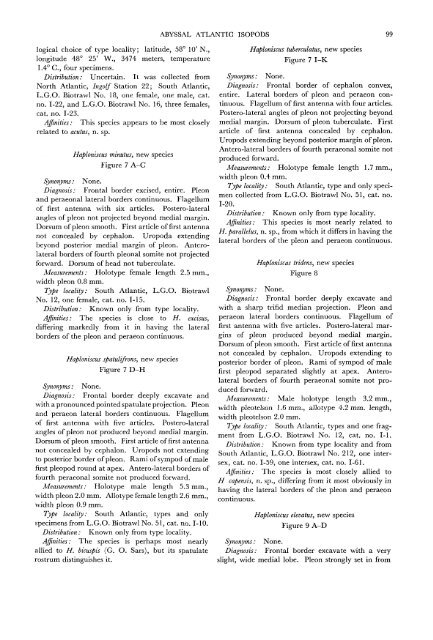The Isopods of Abyssal Depths in the Atlantic Ocean
The Isopods of Abyssal Depths in the Atlantic Ocean
The Isopods of Abyssal Depths in the Atlantic Ocean
Create successful ePaper yourself
Turn your PDF publications into a flip-book with our unique Google optimized e-Paper software.
logical choice <strong>of</strong> type locality; latitude, 58° 10' N.,<br />
longitude 48° 25' W., 3474 meters, temperature<br />
1.4° C, four specimens.<br />
Distribution: Uncerta<strong>in</strong>. It was collected from<br />
North <strong>Atlantic</strong>, Ingolf Station 22; South <strong>Atlantic</strong>,<br />
L.G.O. Biotrawl No. 18, one female, one male, cat.<br />
no. 1-22, and L.G.O. Biotrawl No. 16, three females,<br />
cat. no. 1-23.<br />
Aff<strong>in</strong>ities: This species appears to be most closely<br />
related to acutus, n. sp.<br />
Haploniscus m<strong>in</strong>utus, new species<br />
Figure 7 A-C<br />
Synonyms: None.<br />
Diagnosis: Frontal border excised, entire. Pleon<br />
and peraeonal lateral borders cont<strong>in</strong>uous. Flagellum<br />
<strong>of</strong> first antenna with six articles. Postero-lateral<br />
angles <strong>of</strong> pleon not projected beyond medial marg<strong>in</strong>.<br />
Dorsum <strong>of</strong> pleon smooth. First article <strong>of</strong> first antenna<br />
not concealed by cephalon. Uropoda extend<strong>in</strong>g<br />
beyond posterior medial marg<strong>in</strong> <strong>of</strong> pleon. Anterolateral<br />
borders <strong>of</strong> fourth pleonal somite not projected<br />
forward. Dorsum <strong>of</strong> head not tuberculate.<br />
Measurements: Holotype female length 2.5 mm.,<br />
width pleon 0.8 mm.<br />
Type locality: South <strong>Atlantic</strong>, L.G.O. Biotrawl<br />
No. 12, one female, cat. no. 1-15.<br />
Distribution: Known only from type locality.<br />
Aff<strong>in</strong>ities: <strong>The</strong> species is close to H. excisus,<br />
differ<strong>in</strong>g markedly from it <strong>in</strong> hav<strong>in</strong>g <strong>the</strong> lateral<br />
borders <strong>of</strong> <strong>the</strong> pleon and peraeon cont<strong>in</strong>uous.<br />
Haploniscus spatulifrons, new species<br />
Figure 7 D-H<br />
Synonyms: None.<br />
Diagnosis: Frontal border deeply excavate and<br />
with a pronounced po<strong>in</strong>ted spatulate projection. Pleon<br />
and peraeon lateral borders cont<strong>in</strong>uous. Flagellum<br />
<strong>of</strong> first antenna with five articles. Postero-lateral<br />
angles <strong>of</strong> pleon not produced beyond medial marg<strong>in</strong>.<br />
Dorsum <strong>of</strong> pleon smooth. First article <strong>of</strong> first antenna<br />
not concealed by cephalon. Uropods not extend<strong>in</strong>g<br />
to posterior border <strong>of</strong> pleon. Rami <strong>of</strong> sympod <strong>of</strong> male<br />
first pleopod round at apex. Antero-lateral borders <strong>of</strong><br />
fourth peraeonal somite not produced forward.<br />
Measurements: Holotype male length 5.3 mm.,<br />
width pleon 2.0 mm. Allotype female length 2.6 mm.,<br />
width pleon 0.9 mm.<br />
Type locality: South <strong>Atlantic</strong>, types and only<br />
specimens from L.G.O. Biotrawl No. 51, cat. no. 1-10.<br />
Distribution: Known only from type locality.<br />
Aff<strong>in</strong>ities: <strong>The</strong> species is perhaps most nearly<br />
allied to H. bicuspis (G. O. Sars), but its spatulate<br />
rostrum dist<strong>in</strong>guishes it.<br />
ABYSSAL ATLANTIC ISOPODS 99<br />
Haploniscus tuberculatum, new species<br />
Figure 7 I-K<br />
Synonyms: None.<br />
Diagnosis: Frontal border <strong>of</strong> cephalon convex,<br />
entire. Lateral borders <strong>of</strong> pleon and peraeon cont<strong>in</strong>uous.<br />
Flagellum <strong>of</strong> first antenna with four articles.<br />
Postero-lateral angles <strong>of</strong> pleon not project<strong>in</strong>g beyond<br />
medial marg<strong>in</strong>. Dorsum <strong>of</strong> pleon tuberculate. First<br />
article <strong>of</strong> first antenna concealed by cephalon.<br />
Uropods extend<strong>in</strong>g beyond posterior marg<strong>in</strong> <strong>of</strong> pleon.<br />
Antero-lateral borders <strong>of</strong> fourth peraeonal somite not<br />
produced forward.<br />
Measurements: Holotype female length 1.7 mm.,<br />
width pleon 0.4 mm.<br />
Type locality: South <strong>Atlantic</strong>, type and only specimen<br />
collected from L.G.O. Biotrawl No. 51, cat. no.<br />
1-20.<br />
Distribution: Known only from type locality.<br />
Aff<strong>in</strong>ities: This species is most nearly related to<br />
H. parallelus, n. sp., from which it differs <strong>in</strong> hav<strong>in</strong>g <strong>the</strong><br />
lateral borders <strong>of</strong> <strong>the</strong> pleon and peraeon cont<strong>in</strong>uous.<br />
Haploniscus tridens, new species<br />
Figure 8<br />
Synonyms: None.<br />
Diagnosis: Frontal border deeply excavate and<br />
with a sharp trifid median projection. Pleon and<br />
peraeon lateral borders cont<strong>in</strong>uous. Flagellum <strong>of</strong><br />
first antenna with five articles. Postero-lateral marg<strong>in</strong>s<br />
<strong>of</strong> pleon produced beyond medial marg<strong>in</strong>.<br />
Dorsum <strong>of</strong> pleon smooth. First article <strong>of</strong> first antenna<br />
not concealed by cephalon. Uropods extend<strong>in</strong>g to<br />
posterior border <strong>of</strong> pleon. Rami <strong>of</strong> sympod <strong>of</strong> male<br />
first pleopod separated slightly at apex. Anterolateral<br />
borders <strong>of</strong> fourth peraeonal somite not produced<br />
forward.<br />
Measurements: Male holotype length 3.2 mm.,<br />
width pleotelson 1.6 mm., allotype 4.2 mm. length,<br />
width pleotelson 2.0 mm.<br />
Type locality: South <strong>Atlantic</strong>, types and one fragment<br />
from L.G.O. Biotrawl No. 12, cat. no. 1-1.<br />
Distribution: Known from type locality and from<br />
South <strong>Atlantic</strong>, L.G.O. Biotrawl No. 212, one <strong>in</strong>tersex,<br />
cat. no. 1-59, one <strong>in</strong>tersex, cat. no. 1-61.<br />
Aff<strong>in</strong>ities: <strong>The</strong> species is most closely allied to<br />
H capensis, n. sp., differ<strong>in</strong>g from it most obviously <strong>in</strong><br />
hav<strong>in</strong>g <strong>the</strong> lateral borders <strong>of</strong> <strong>the</strong> pleon and peraeon<br />
cont<strong>in</strong>uous.<br />
Haploniscus elevatus, new species<br />
Figure 9 A-D<br />
Synonyms: None.<br />
Diagnosis: Frontal border excavate with a very<br />
slight, wide medial lobe. Pleon strongly set <strong>in</strong> from

















